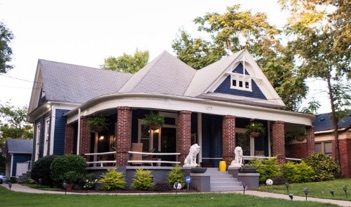It is a fun time in the Historic West End these days!! The Atlanta Beltline is set to open late summer along with 3 breweries and a distillery, two new restaraturants, and a housing market that doesn’t look like it’s slowing down any time soon! With the recent record breaking sale of 1174 Oglethorpe at $425,000 everyone in Atlanta has its eyes on Atlanta’s Historic West end!
I read a lot of articles from well-known publications in Atlanta that talk about new developments on the west side and when I scroll down and read the comments although the area has achieved a lot of success over the past 3 years, there is still a very negative view of the West end. The majority of these comments are primarily from people who it seems haven’t been to the neighborhood recently, but nevertheless our neighborhood still has some speculation from outsiders. This is one of the many reasons why the Historic West End Tour of Homes exist!
Check out this sneak peak of a few of the homes that will be featured on the tour. Also, if you’re interested in learning more history on the neighborhood be sure to check out the Insight Cultural Tourism walking tour while your Intown!
The West End Tour of Homes is Saturday, June 24, 2017. Get your discount tickets Here. Use the discount code EBA5off. (The discount expires 6/16/17)
Victorian at 1050 Ralph David Abernathy Blvd SW
The Wren’s Nest was the home of Joel Chandler Harris from 1881 until 1908.
The structure is one of only a few remaining Queen Anne Victorian homes in Atlanta. It’s a unique example of upper middle class living around the turn of the 20th century. Today, the home features most of the Harris family’s original furniture and belongings.
The house was named after the wrens made a nest in the mailbox 120 years ago. If you visit in the spring, you might see that wrens still make nests in the mailbox.
The museum officially opened as a house museum in 1913, with financial support from Andrew Carnegie, President Theodore Roosevelt, and the fundraising efforts of kids from Atlanta Public Schools. The east parlor served as The Uncle Remus Memorial Carnegie Library until 1930. The books eventually became too heavy for the floor, and the library was moved down the street.
Esther LaRose, Harris’ wife, kept the author’s bedroom intact after his death. It is almost completely untouched to this day, aside from cleaning, wallpaper repair, and the occasional changing of the bed linens.
From The Wren’s Nest Website and Facebook Page
Victorian at 503 Peeples Street SW
Nestled on a quiet residential street in Atlanta’s historic West End, Hammonds House Museum is a unique setting to explore the cultural diversity and legacy of artists of African descent.
The Museum is the former residence of the late Dr. Otis Thrash Hammonds, who was aprominent Atlantaphysician and a passionate arts patron. The Museum opened in 1988 to continue Dr. Hammonds’ commitment to preserving and celebrating art from the African Diaspora, and offers a year-round calendar of fine art exhibitions and cultural programming.
Hammonds House Museum boasts a permanent collection of more than 350 works dating from the mid-19th century by artists from America, Africa, and the Caribbean. Highlights of the collection include 18 works by master artist Romare Bearden and the oldest known painting by acclaimed landscape artist Robert S. Duncanson. Benny Andrews, Elizabeth Catlett, Sam Gilliam, Richard Hunt, Jacob Lawrence, P.H. Polk, Hale Woodruff, and James Van Der Zee are among the scores of important regional, national, and international artists represented in the collection.
Craftsman at 566 West End Place SW
Formerly 33 Bunker and 33 West End Place, the building permit was applied for on April 5, 1910 and completed August 2, 1910.
Bunker Street was named for F.R. Bunker, a West End City Councilman who lived on Gordon street (now Ralph David Abernathy) on the site of West Hunter Baptist church.
Bunker street only contained three buildings, all of which were servant’s quarters for Mr. Bunker’s household staff. He sold the property to developers Eubanks and Gunn.
The first residents were Harry Cooke Robert, his wife Myra, their three sons and Myra’s mother, Julia Cole. Harry was a bookseller until 1918 when he passed the Georgia Bar and became a lawyer. He practiced law for two years and then became credit manager for F.J Cooledge and Sons, a paint company.
Julia died at the home in 1940. Harry died suddenly, in his office, in 1943.
Myra Robert stayed in their home on West End Place for the rest of her life, dying in November 1967 at the age of 86. She had rented out rooms in the house for the last twenty years.
Victorian at 1277 Sells Avenue SW
Formerly 285 and 601 Sells Avenue, this house was built in the 1890s. This area was not a part of Atlanta until 1910; early records are scarce.
In 1899, this property was owned by James S. Nichols, a railroad clerk and auditor, and his wife Jennie. They had three daughters.
By 1901, the residents were Mrs. Minnie Ford, the widow of Charles Ford, and her son Alf C. Ford, a clerk with Hartford Fire Insurance Company. Charles Ford died in 1889 at the age of 27 of consumption.
In 1902, the house was owned by three siblings, Benjamin Ward, Maggie Ward and Josie Ward. Maggie and Josie were both nurses. Benjamin lived to be 87 years old and Maggie lived to be 92.
In 1914, the home was sold for $500 to Leonora Raines. Mrs. Raines was a war correspondent in the early years of World War I. She was arrested as a German spy and subjected to numerous other hardships. She visited many active battlefields for her first-hand, authentic reports. She never moved into the house and it remained vacant for several years.
Walter A. Rhodes, and his wife Josie, bought the house in 1920, and lived there until 1934.
Bungalow at 959 Beecher Street SW
The building permit was applied for on March 13, 1922 and completed July 27, 1922. This home was built as a duplex, containing 12 rooms and 2 bathrooms at a cost of $10,000.
GG Long Co, the builder, constructed more than 150 homes in West End between 1920 and 1922.
The home had many short term residents until Joseph Tommey and his wife, Estelle, moved in as renters in 1930. Joseph was a veteran of the Spanish-
American War, serving for several years in Manila. He was later a baker in Atlanta.They continued to rent 959 Beecher until Joseph Tommey died in 1942. He had lived in the West End community for 28 years.
Later, the extended Bidez family occupied both sides of the duplex. Before moving to Beecher street, RV Bidez, an inventor, built a machine to eliminate radio static, which was a major problem in 1929. He was also a linotype operator for the Atlanta Constitution. His sons served in World War II. Robert received a Purple Heart. Souvenirs he brought home from the front were a .32 caliber Walther gun, a .38 caliber Luger and captured Nazi flags. RL Bidez organized and directed the first student band at Georgia Tech in 1908. The boys learned “ The Rambling Wreck” by ear (the music was not written down until 1912) and were the first to play it at a Tech football game!
Happy Touring!






